RAS (recirculating aquaculture system) fish farming is a rapidly growing industry due to the increasing demand for fish and the decline of wild fish populations. However, traditional fish farming practices can negatively impact the environment and fish populations. That’s why sustainable RAS fish farming practices are becoming increasingly important.
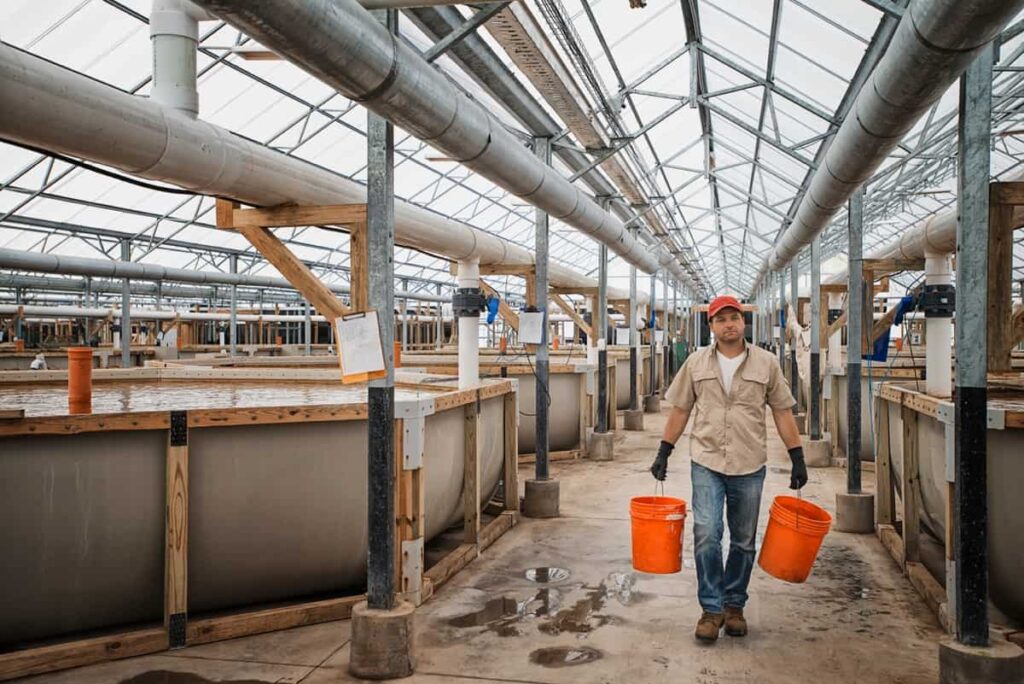
The Food and Agriculture Organization (FAO) says that over 70% of the world’s fish populations are either fully used, overused, or gone. Additionally, the FAO estimates that by 2030, fish farming will provide more than 50% of the world’s fish for human consumption. This highlights the importance of sustainable fish farming practices to ensure the future of the industry and the availability of fish as a food source.
Sustainable RAS fish farming practices benefit the environment and can bring economic and social benefits. For example, renewable energy sources can reduce energy costs, while proper waste management can prevent water pollution and disease outbreaks. By adopting sustainable practices, RAS fish farmers can ensure a long-term, profitable, and responsible industry.
Sustainable RAS Fish Farming Practices
What is RAS in Fish Farming?
- Recirculating Aquaculture System (RAS) is a technology that has been developed to address the growing demand for fish sustainably and responsibly.
- Unlike traditional outdoor fish farming methods, RAS is an intensive high-density fish culture that utilizes minimum land area and water.
- In RAS, fish are typically reared in indoor/outdoor tanks in a controlled environment. Water is filtered and cleaned by recycling it back to fish culture tanks after mechanical and biological filtration and removing suspended matter and metabolites.
- Any species grown in aquaculture can be used with the technology built on mechanical and biological filters. New water is introduced to the tanks only to compensate for splash out and evaporation, which is used for flushing out waste materials.
- The system circulates the reconditioned water, and up to 10% of the system’s total water volume is replenished daily. The amount and quality of feed and the type of filtration are crucial factors in efficiently administering recirculating systems.
- In recirculating networks, various filter designs are employed. Nevertheless, all filtration aims to provide excellent water quality for aquatic creatures by removing metabolic wastes, excess nutrients, and solids from the water.
- Backyard recirculation aquaculture systems are being pushed to support small-scale fish farmers and business owners and make it easier to produce fish in urban and semi-urban areas without land and water.
In case you missed it: Fish Hatchery Business Plan: How to Start, Cost, Profits, and a Great Way to Make Money
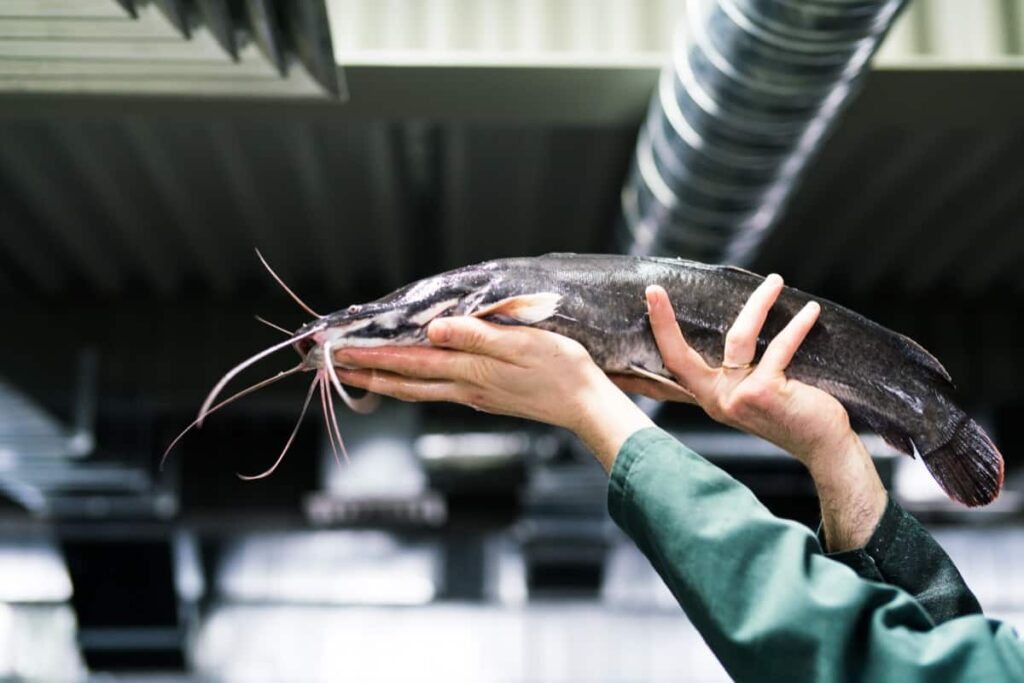
Fundamentals of Successful RAS Fish Farming
- RAS (recirculating aquaculture system) fish farming can be highly profitable, but it requires the right system design, feed, management practices, and feeding strategy to be successful.
- Water quality is the key to healthy fish and optimal performance. A well-designed RAS system uses mechanical and biological filters to remove organic matter, ammonium, and CO2 from the water, ensuring a consistent, high growth rate and good fish health.
- Management practices should maintain optimal water quality parameters, such as dissolved oxygen, ammonia levels, and pH, to ensure consistent feed uptake, digestion, growth, and waste excretion.
- Feeding is also critical to RAS’s success. A RAS feed should be highly digestible, producing minimal fecal matter and high protein retention that minimizes ammonia excretions so that the filters can work more efficiently.
- A good RAS feed maximizes nutrient utilization and minimizes nutrient losses for optimal fish growth. The physical pellet properties of the feed should minimize water contamination, including firmness, sinking speed, and durability.
- Overfeeding and using lower-quality feeds can increase pollution levels in the system, affecting water quality and fish growth.
How Sustainable RAS Fish Farming Works?
- Recirculating Aquaculture Systems (RAS) is an eco-friendly and sustainable way of farming fish.
- Water is drawn from a source and passed through mechanical filters to remove large solids and biological filters to remove toxic ammonia and nitrite.
- The filtered water is then oxygenated and sent to the fish tanks.
- Fish are fed, and the waste they produce accumulates in the tanks.
- The waste is removed through various means, such as settling tanks, biofilters, and protein skimmers.
- The treated water from the tanks is then recirculated to the fish tanks, completing the cycle.
- The RAS system uses minimal water and energy, making it a sustainable option for fish farming.
- The controlled environment of RAS allows for better disease prevention and optimal growth conditions for the fish.
- The RAS system also allows producing high-quality, healthy fish without antibiotics or other harmful chemicals.
- The sustainable aspect of RAS also makes it a profitable option for farmers as it reduces the impact on the environment and lowers production costs.
In case you missed it: How to Start Polyculture Fish Farming In India: Composite Fish Culture, Mixed Fish Farming Examples, Benefits, and Disadvantages
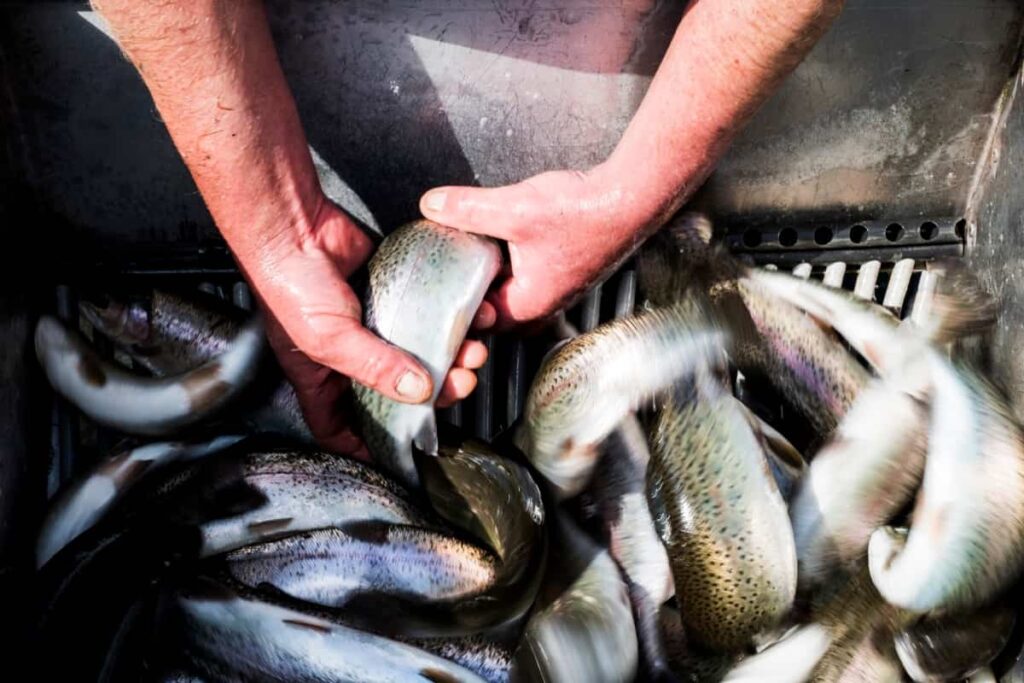
Is Sustainable RAS Fish Farming Profitable?
- Sustainable RAS fish farming can be profitable but requires careful planning and management.
- Market demand: Ensure a steady demand for your fish and assess the competition in the market.
- Production costs: RAS fish farming can have high initial capital investment costs, but operating costs can be minimized with good management practices.
- Feed costs: Feeding fish is one of the most significant expenses in RAS fish farming. Using high-quality feed and optimizing feed conversion rates can help reduce costs.
- Labor costs: Efficient labor management and automation can help reduce labor costs.
- Fish growth and survival rates: Proper management practices can help ensure optimal growth and survival rates, resulting in higher profits.
- Government incentives: Some programs offer financial and technical assistance to help sustain RAS fish farming businesses.
How To Start a Sustainable RAS Fish Farming
- Sales: Establishing sales prices and volumes is crucial to the success of your operation. Ask yourself what product value needs to be added to your target audience.
- Tank size: Tanks come in different sizes and shapes, but a circle or oval shape is preferable for better water circulation and cleaning. Tank capacity depends on the fish type, water requirements, and stock density.
- Water flow: Constant water flow is important in RAS fish farming, with pump speed alteration possible when necessary.
- Grass cutting: Clear grass around the fish tank for proper aeration.
- pH level: Maintain a pH level between 6-9.5, and use buffers like Sodium Bicarbonate and Calcium Bicarbonate to help maintain it.
- Feeding: Feed the fish according to their weight and growth, with a diet high in protein and essential minerals. Avoid overfeeding to prevent water contamination, and store feed in a cool, dry place.
- Financing: You’ll need funding to start your RAS operation privately or through grants or loans. Bringing in investors with technical know-how can be beneficial.
- Legal restrictions: Make sure you understand federal, state, and local regulations regarding aquaculture, including restrictions on pollution and discharge of wastewater effluents, fish transportation, and species of fish to be reared and sold.
Equipment for Sustainable RAS Fishing
- Biofilters: Biofilters play a vital role in detoxifying waste and uneaten food from fish tanks. They are used to capture harmful chemicals and break them down into less toxic compounds.
- Pumps: Pumps circulate water in and out of the fish tank. They are necessary to maintain the quality of water in the tanks.
- Aeration devices: Aeration devices help to provide oxygen to the fish and improve water quality by recycling water after removing impurities.
- Generators: Generators produce ozone, a volatile gas that helps maintain good water quality and kills viruses produced by ammonia nitrogen.
- Grading equipment: Grading equipment separates fish of different sizes during harvesting.
- Other important components in RAS include water tanks, fish tanks, UV sterilizers, sludge collectors, insulated sheds, settling tanks for sludge, water testing kits, and stores for feed and accessories.
In case you missed it: Contract Fish Farming in India: Companies, Agreement, Profits, Process, Benefits, and Risks

How to Avail Subsidy for RAS Fish Farming
- To avail subsidy for RAS fish farming, the beneficiary must submit a project report and the required documents to the District Fisheries Office.
- The project report should include species to be cultured, capital cost, recurring cost, details of anticipated employment generation, enhancement of fish production, and specific timelines for project implementation.
- The beneficiary can also submit a Self-Contained Proposal with full justification and techno-economic details.
- Governmental assistance is limited to one large, medium, or small RAS unit for an individual beneficiary. For a group of fishers and fish farmers, the assistance is limited to 2 large units, three medium units, or four small RAS units per group or society.
- However, a cluster/area may have multiple groups/societies. The modalities of implementation and upper ceiling on the total area eligible for support would be decided by the concerned authority.
Benefits of Sustainable RAS Fish Farming Practices
- Environmentally sustainable: The sustainable RAS fish farming system is designed to reduce the environmental impact of fish farming. It eliminates the need for large amounts of water and decreases the amount of waste released into the environment.
- Efficient use of resources: The RAS fish farming system efficiently uses resources, such as water and energy. It recycles and reuses water, reducing the need for freshwater sources. It also uses less energy to maintain the fish’s environment.
- Higher yields: RAS fish farming allows for higher yields because it provides a controlled and stable environment for the fish. The fish can grow faster and healthier, resulting in a higher yield and better quality fish.
- Disease prevention: RAS fish farming practices help prevent disease spread by isolating the fish from outside sources of pathogens.
- Higher profits: Sustainable RAS fish farming practices can result in higher profits due to increased yields and reduced operating costs. It also provides a consistent supply of fish throughout the year, essential for maintaining steady revenue streams.
- Employment opportunities: RAS fish farming practices can create employment opportunities for the local community, as it requires skilled and unskilled labor.
- Sustainable food production: Sustainable RAS fish farming practices contribute to sustainable food production, which is necessary to meet the growing demand for food globally.
In case you missed it: Common Fish Diseases, Symptoms, and Treatment: Check How this Guide Helps Fish Farmers
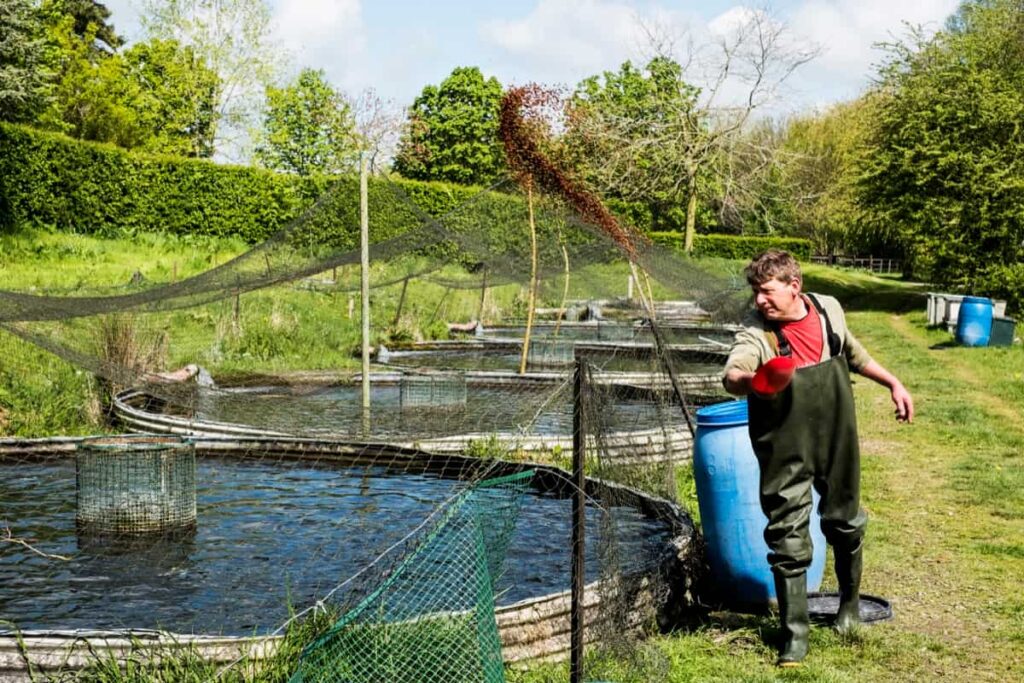
Fish Types Suitable for the RAS Fishing?
- Tilapia – Tilapia is a popular fish species that grows easily in RAS. They tolerate various water conditions and can survive in low-oxygen environments. Tilapia is a fast-growing fish that can reach harvest size in a short time.
- Trout – Trout is another popular fish species for RAS. They require cold, well-oxygenated water, making them an ideal choice for RAS systems. Trout is a high-value fish, making them a profitable choice for farmers.
- Catfish – Catfish is another fish species that is suitable for RAS farming. They are hardy fish and can tolerate a wide range of water conditions. Catfish are also fast-growing fish, making them an ideal choice for RAS systems.
- Salmon – Salmon is a high-value fish that is suitable for RAS farming. They require cold, well-oxygenated water and a high-protein diet. Salmon is a popular fish among consumers, making them a profitable choice for farmers.
- Barramundi – Barramundi is a warm-water fish that is suitable for RAS farming. They require warm water and a high-protein diet. Barramundi is a high-value fish, making them a profitable choice for farmers.
The Future of Sustainable RAS Fish Farming
- Increased automation: With the advancement of technology, automation can be used to monitor and control water quality, feeding, and fish growth. This will increase efficiency and reduce labor costs.
- Expansion of fish species: RAS technology is suitable for several fish species, and as research continues, more fish types may be added to the list. This will increase diversity and market potential.
- Better energy efficiency: RAS technology has the potential to become more energy-efficient by utilizing renewable energy.
- Integration with aquaponics: Aquaponics is a sustainable farming method that combines fish farming with hydroponic vegetable cultivation. RAS can be integrated with aquaponics to create a closed-loop system that maximizes resource utilization and reduces waste.
- Increased acceptance: As consumers become more aware of the environmental impact of food production, sustainable fish farming methods such as RAS will become more popular. This will create a growing market for RAS-produced fish.
- Research and development: The RAS industry is still relatively young, and there is a lot of room for research and development to improve the technology and increase its efficiency. As research continues, the future of sustainable RAS fish farming looks bright.
In case you missed it: Unlocking the Potential Of Sustainable Aquaculture: How to Start and What You Need to Know
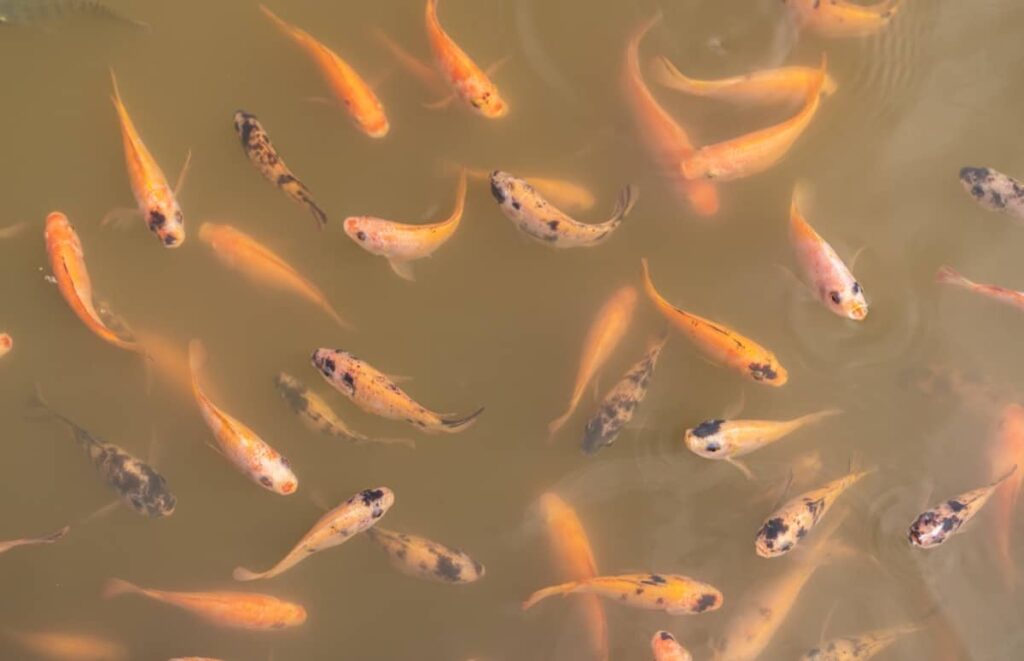
Conclusion
Sustainable RAS fish farming is an innovative and eco-friendly method of fish production. It offers numerous advantages, including high yields, reduced water consumption, and minimal environmental impact. We can meet the growing demand for fish while conserving natural resources by employing sustainable RAS fish farming practices.
- How to Raise Pigs in Your Own Backyard: A Comprehensive Guide
- Budget Friendly Sheep Shed Ideas: Cheap and Low-Cost Tips
- How Much Do Cattle Farmers Make: Revenue Streams in Cattle Farming
- Management Pests and Diseases in Your Cotton Field
- Sheep Farming Business Plan for Beginners
- Aquaponic Farming at Home: A Step-By-Step Guide
- Profitable Village Farming Business Ideas in 2024
- High-Yield Aquaculture: Fast-Growing Fish for Farming
- Effective Fish Pond Construction Techniques for Beginners
- Irrigation and Water Management in Pineapple Farming
- Blossom to Harvest: Mastering Flowering and Pollination in Papaya Farming
- Pig Fattening Essentials: From Selection to Sale for Beginners
- Raising Wagyu Cattle: A Complete Guide for Premium Beef Production
- Soil Types and Their Water Holding Capacity
- Optimizing Irrigation Schedules for Coconut Groves for Enhanced Yield
- Espresso Your Garden: Coffee Grounds for Healthier Acid-Loving Plants
- The Best Soil Mix for Snake Plants: How to Mix Your Own Snake Plant Soil
- Green Thumb Success: Expert Tips for Cultivating Greenhouse Beans All Year Round
- Bloom All Year Round: The Ultimate Guide to Indoor Hyacinth Care
- Eco-Friendly Gardening: How to Make Liquid Fertilizer from Kitchen Waste
- Ultimate Guide to Grow Anise in Pots: Explore Seed Propagation to Harvesting
- Guide to Raising Chester White Pigs: Discover Breed Facts to Growth Management
- Mastering the Elegance: The Ultimate Guide to Weeping Cherry Tree Care, Planting, and Maintenance
- Ultimate Guide to Planting Garlic in Grow Bags: Growing Strategies for Beginners
- How to Fix Spider Plant Leaf-Related Problems: Natural and Organic Remedies
- 10 Reasons Why Your Tulsi Plant is Shedding Leaves: Home Remedies and Solutions
- Optimizing Growth and Yield: The Advantages of Palm Bunch Ash Fertilizer
- Utilizing Neem Oil Extract as a Natural Pesticide for Hydrangea
- From Soil to Harvest: Various Ways in Which Farmers Can Use AI Tools
- Steps to Encourage and Induce Citrus Flowers: A Comprehensive Guide
- How to Fix Snake Plant Leaf-Related Issues: Natural and Organic Remedies
- Transform Your Garden into a Fragrant Oasis with Raat Ki Rani (Night Blooming Jasmine)
- Discover the Ideal Chicken Breeds for Philippine Farms
- How to Create a Poultry Egg Farm Business Plan for Profits
- Grow Lemon Cucumbers Like a Pro: Insider Techniques for Bountiful Yields
- Ultimate Guide to Caring for Your Pink Princess Philodendron: Tips for Thriving Variegation

I agree